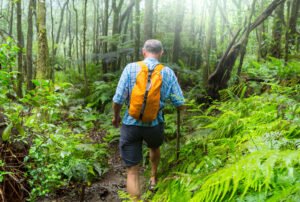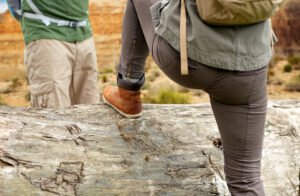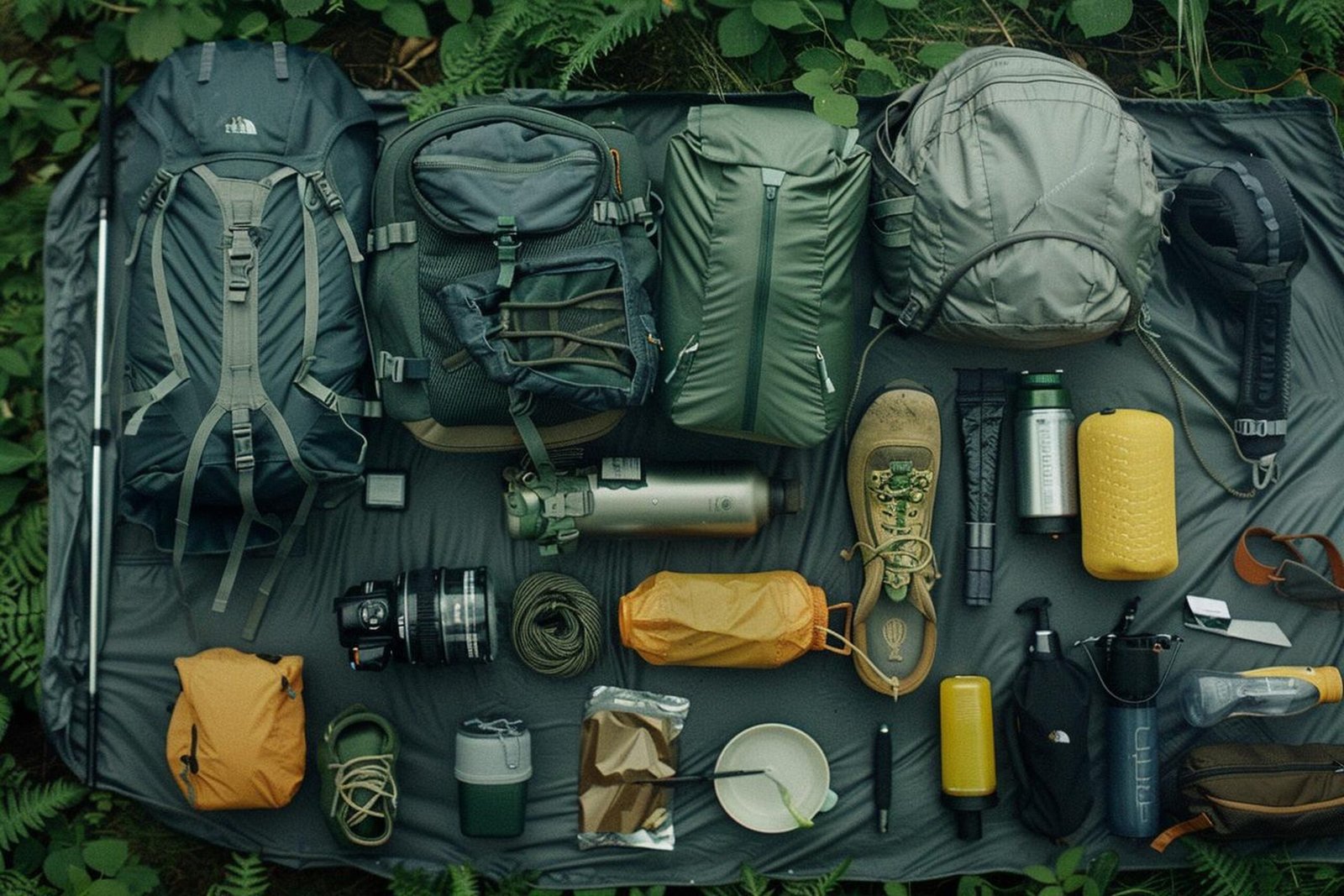Green Gear Revolution: How Eco-Friendly Hiking Materials Are Saving Our Trails
Eco-friendly hiking materials are revolutionizing trail conservation. Find out how to choose the best sustainable gear in our guide.
Did you know that 20 million pounds of plastic pollution from outdoor activities end up in our oceans every year? This staggering number highlights the hidden environmental cost of traditional gear. From backpacks to water bottles, the items we rely on for adventure often leave a lasting mark on the planet.
Thankfully, a shift is underway. More brands are turning to sustainable materials like recycled polyester and bio-based fabrics. Companies such as Klean Kanteen and Patagonia are leading the charge, proving that innovation and conservation can go hand in hand.
This article aims to guide you in making smarter choices for your next adventure. By opting for gear that prioritizes the environment, you can help protect the trails you love. Let’s explore how small changes in your gear can make a big difference.
Why Eco-Friendly Hiking Materials Matter
The choices we make on the trail ripple far beyond our footprints. Synthetic materials, commonly used in outdoor gear, contribute significantly to microplastic pollution. These tiny particles often end up in waterways, harming marine life and ecosystems. Additionally, discarded gear adds to landfill waste, taking centuries to decompose.
Petroleum-based production processes for traditional gear also have a heavy environmental impact. The carbon emissions from manufacturing contribute to climate change, further threatening the natural spaces we cherish. By choosing sustainable hiking gear, we can reduce this footprint and protect the planet.
Non-biodegradable gear left behind on trails can lead to erosion and habitat disruption. Abandoned items, such as plastic bottles or broken equipment, degrade the beauty of nature and harm wildlife. Brands like Klean Kanteen are making a difference by eliminating over 50 million single-use bottles, showing how small changes can have a big impact.
Every purchase we make as hikers sends a message. Opting for gear made from recycled or biodegradable materials helps reduce marine debris and supports conservation efforts. Together, we can ensure that our adventures leave only positive memories behind.

Understanding Eco-Friendly Materials
Innovative materials are reshaping the way we think about outdoor gear. From recycled fabrics to bio-based innovations, these options are designed to reduce environmental impact while maintaining performance. Let’s explore the key types of materials leading this change.
Recycled Fabrics: Turning Waste into Gear
Recycled polyester is a game-changer in the outdoor industry. Brands like Gregory use 40% recycled materials in their packs, transforming post-consumer plastic into durable performance fabrics. Columbia has also stepped up, crafting jackets from over 70 recycled bottles. These efforts help reduce waste and conserve resources.
Natural Fibers: Biodegradable and Sustainable
Natural fibers like hemp are gaining popularity for their low environmental impact. Hemp decomposes in 1-2 years, compared to nylon, which can take 30-40 years. This makes it an excellent choice for gear that needs to be both strong and sustainable.
Bio-Based Materials: The Future of Hiking Gear
Bio-based materials are paving the way for a greener future. Big Agnes uses castor bean-based insulation in their sleeping bags, offering a renewable alternative to traditional fillers. ENO’s 100% recycled nylon hammocks are another example of how innovation is driving sustainability.
Certifications like bluesign® ensure that these materials are produced with minimal chemical impact. By choosing gear made from recycled or bio-based materials, you’re supporting a healthier planet. Every piece of gear you buy can make a difference.
Top Eco-Friendly Hiking Gear Brands
Many outdoor brands are now leading the way in eco-conscious innovation. From footwear to backpacks, these companies are creating products that minimize environmental impact while delivering top performance. Let’s explore some of the best options available today.
KEEN Footwear: Combining Quality and Sustainability
KEEN is a standout brand known for its commitment to sustainability. Their Targhee boots feature PFC-free waterproofing and Eco Anti-Odor technology, ensuring durability without harmful chemicals. Beyond their products, KEEN has donated over 100,000 shoes to those in need, showcasing their dedication to making a positive impact.
Gregory Packs: Minimizing Environmental Footprint
Gregory is another leader in eco-friendly gear. Their Juno 24 pack uses a lining made recycled materials, specifically 40% post-consumer polyester. They’ve also reduced packaging waste by 21%, proving that small changes can significantly lower their footprint. This focus on sustainability ensures that their backpacks are as kind to the planet as they are to your shoulders.
ENO Hammocks: Relaxing with a Clear Conscience
ENO takes sustainability seriously by planting two trees for every hammock sold through their partnership with Trees for the Future. Their products are designed for comfort and durability, making them a favorite among outdoor enthusiasts. By choosing ENO, you’re not just investing in quality gear but also supporting reforestation efforts.
These brands are setting a new standard for sustainable hiking gear. By supporting them, you’re contributing to a healthier planet while enjoying high-performance products. Explore more about eco-conscious gear options here.
Essential Eco-Friendly Hiking Gear
Choosing the right gear can transform your outdoor experience while protecting the planet. From footwear to sleeping bags, every item you carry plays a role in reducing your environmental impact. Let’s explore some of the best options available today.
Footwear: Durable and Sustainable Options
Your boots are one of the most important items for any adventure. KEEN’s NXIS Evo boots feature an anatomical footbed design, ensuring comfort and support on long treks. These boots are made with PFC-free waterproofing, reducing harmful chemical use.
Another great option is the Merrell Moab 3, crafted with recycled materials. These shoes are lightweight, durable, and perfect for various terrains. By choosing sustainable footwear, you’re investing in both performance and the planet.
Backpacks: Lightweight and Eco-Conscious Designs
A good backpack is essential for carrying your camping gear. Osprey’s ultralight packs, made from recycled nylon, are a top choice. These packs are designed to minimize weight without sacrificing durability.
Gregory’s Juno 24 is another excellent option, featuring 40% post-consumer recycled materials. Its ergonomic design ensures comfort, even on long hikes. These backpacks prove that sustainability and functionality can go hand in hand.
Sleeping Bags: Comfort Meets Sustainability
A good night’s sleep is crucial for any outdoor adventure. Big Agnes sleeping bags use 50-100% recycled insulation, offering warmth without compromising the environment. The Marmot Trestles Elite Eco bag features a DWR finish, ensuring water resistance and durability.
When choosing a sleeping bag, consider the R-value of synthetic vs. recycled down insulation. Both options provide excellent warmth, but recycled materials reduce your environmental footprint. With these items, you can rest easy knowing you’ve made a sustainable choice.
How to Choose the Right Eco-Friendly Hiking Gear
With 52% of consumers prioritizing sustainability, choosing the right gear has never been more important. Making informed choices ensures your outdoor adventures align with your values. Here’s how to navigate the options and select gear that’s both functional and kind to the planet.
Researching Brands and Materials
Start by looking for brands committed to sustainable practices. Certifications like GOTS and Fair Trade are excellent indicators of ethical production. For example, Gregory offers lifetime repair services, embodying the “buy once” philosophy. This approach reduces waste and ensures your gear lasts for years.
Compare options from brands like Patagonia, which reduces emissions by 30% through its Worn Wear program. Researching materials is equally important. Opt for recycled fabrics or bio-based innovations that minimize environmental impact.
Focusing on Versatility and Durability
Versatile gear reduces the need for multiple items, saving resources and money. Look for products that adapt to different conditions, like multi-season sleeping bags or convertible jackets. Durability is also key—invest in gear that withstands wear and tear, ensuring it doesn’t end up in a landfill prematurely.
Brands like KEEN and Osprey excel in creating durable, versatile options. Their products are designed to perform in various environments while maintaining a low environmental footprint.
Considering Second-Hand and Recycled Options
Second-hand gear is a fantastic way to reduce waste and save money. Programs like REI Used Gear offer high-quality items at a fraction of the cost. For example, a used backpack from REI can cost 40% less than a new one, making it a budget-friendly choice.
Rental platforms like Arrive Outdoors are another great option. They allow you to access premium gear without the long-term commitment. By choosing second-hand or rented gear, you’re supporting circular economy practices and reducing demand for new production.
For more tips on selecting sustainable hiking gear, explore our comprehensive guide. Every choice you make helps protect the trails and the planet.
Sustainable Manufacturing Practices in Hiking Gear
The way gear is made impacts the planet as much as how it’s used. Many brands are now adopting sustainable practices to reduce their environmental footprint. From ethical labor to energy-efficient methods, these efforts are transforming the industry.

Ethical Production and Fair Labor Practices
Ethical production ensures that workers are treated fairly and paid a living wage. Brands like Big Agnes lead by example, using 100% renewable energy in their facilities. This commitment extends to their supply chain, ensuring every step aligns with their values.
Fair labor practices also include safe working conditions and transparency. Companies that prioritize these standards often hold certifications like Fair Trade, which guarantee ethical treatment of workers.
Energy-Efficient and Water-Conserving Methods
Reducing energy and water use is critical in sustainable manufacturing. Solar-powered factories, like those used by NEMO Equipment, cut reliance on non-renewable energy. These facilities generate clean power, significantly lowering their carbon emissions.
Closed-loop water systems are another innovation. They recycle water during dyeing processes, minimizing waste. NEMO also uses chemical-free DWR treatments, reducing harmful environmental impacts.
Longevity and Repair Services
Creating durable products is a cornerstone of sustainability. Arc’teryx’s ReBIRD program repairs gear, extending its lifespan and reducing waste. This initiative has saved thousands of products from landfills.
Brands that offer repair services encourage a “buy once” philosophy. This approach not only saves money but also reduces the demand for new production, lowering the industry’s overall footprint.
| Brand | Practice | Impact |
|---|---|---|
| Big Agnes | 100% renewable energy | Reduces carbon emissions |
| NEMO Equipment | Chemical-free DWR treatments | Minimizes water pollution |
| Arc’teryx | ReBIRD repair program | Extends product lifespan |
Making Eco-Friendly Choices on the Trail
Every step on the trail can either harm or help the environment. With 292 million tons of waste generated annually in the U.S., it’s clear that our actions matter. By adopting sustainable habits, we can reduce our impact and protect the planet for future generations.
Leave No Trace Principles
Following Leave No Trace principles ensures that your presence on the trail leaves minimal impact. Proper waste disposal is crucial—pack out all trash, including food scraps and plastic wrappers. Use biodegradable soap for cleaning, and avoid chemical alternatives that can harm the environment.
Another key principle is respecting wildlife. Stay on marked paths to prevent erosion and habitat disruption. By adhering to these guidelines, you’re helping preserve the natural beauty of the trail.
Proper Gear Maintenance and Care
Taking care of your gear extends its lifespan and reduces waste. Reproofing waterproof membranes and seam sealing can keep your equipment in top condition. Regularly clean and inspect your gear to prevent damage and ensure it’s ready for your next adventure.
Brands like Zeal Optics are leading the way with reef-safe sunscreen partnerships, showing how small changes can make a big difference. By maintaining your gear, you’re investing in its longevity and reducing your environmental footprint.
Minimalist Packing for a Smaller Footprint
Packing light not only makes your hike easier but also reduces your impact on the planet. Compare ultralight packing lists to traditional setups—opt for multi-use items like a sleeping bag that doubles as a blanket. This approach minimizes waste and ensures you only carry what you need.
Choose durable, high-quality items that last longer, reducing the need for replacements. By adopting minimalist packing habits, you’re contributing to a healthier environment and a more enjoyable hiking experience.
The Future of Sustainable Hiking Gear
The outdoor industry is evolving with groundbreaking advancements in sustainability. From cutting-edge materials to consumer-driven demand, the way we approach outdoor gear is changing for the better. Let’s explore what’s on the horizon for eco-conscious adventurers.
Innovations in Eco-Friendly Materials
New materials are revolutionizing the outdoor gear landscape. For example, the BioLite CampStove 2 uses biomass energy to cook meals, reducing reliance on fossil fuels. Small brands are also researching mycelium insulation, which could replace traditional synthetic fillers.
Mushroom-based packaging prototypes are another exciting development. These biodegradable alternatives to plastic could significantly reduce waste. By 2025, the industry aims to achieve circular production, where products are designed for reuse and recycling.
Consumer Awareness and Demand
Consumers are playing a key role in driving sustainability. Recent surveys show that 68% of people are willing to pay a premium for eco-friendly products. This shift in mindset is pushing brands to prioritize ethical practices and transparent supply chains.
Advancements in solar-powered gear charging are also gaining traction. These innovations not only reduce environmental impact but also enhance convenience for outdoor enthusiasts. The demand for sustainable options is shaping the future of the industry.
Supporting Conservation Efforts
Many companies are partnering with organizations to support conservation. The Conservation Alliance’s 2023 grants funded projects that protect natural habitats and promote biodiversity. These efforts ensure that outdoor spaces remain pristine for future generations.
By choosing gear from brands that support these initiatives, you’re contributing to a healthier planet. Explore more about sustainable hiking gear and how it’s making a difference.
| Innovation | Impact |
|---|---|
| BioLite CampStove 2 | Reduces fossil fuel use |
| Mycelium insulation | Replaces synthetic fillers |
| Solar-powered gear | Enhances convenience |
Your Next Step Towards Sustainable Hiking
Taking the next step towards a greener adventure starts with informed choices. Look for certifications like bluesign® or Fair Trade when selecting gear. These labels ensure products are made with minimal impact on the planet.
Support brands like Klean Kanteen, known for their Climate Lock technology, or those partnered with 1% for the Planet. These companies are paving the way for a more sustainable future. Consider attending local gear swap events to give used items a second life.
Learn DIY repair techniques to extend the lifespan of your gear. Simple fixes can save money and reduce waste. Advocate for conservation by joining initiatives like the Conservation Alliance, which protects the beauty of natural spaces.
Share your sustainable adventure stories to inspire others. Every small step contributes to a healthier planet. Together, we can make a difference—one informed choice at a time.



